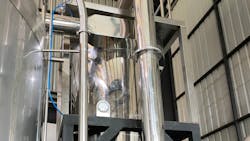Barry on Batteries: Decipher Solids Drying Decisions
When it comes to battery materials, there are many types of solid-liquid separation and centrifugation technologies available. Here, the challenges begin with the slurry formulation. The slurry suspension includes multiple components such as cathode and anode materials, binders and additives. Plus, slurry stability and flowability impact the downstream processes. There are many characteristics to analyze to determine the best slurry mix. Considerations include particle size distribution and particle interactions, such as zeta potential, tendencies to agglomerate, viscosity, density, pH and temperature. I will examine these factors in a future column, along with testing and data collection.
But for now, solids drying is the next step. To that end, we will focus on several dryer alternatives available.
Selecting The Right Dryer
Depending on the process step, there are several alternatives for the dryer. Let’s begin with the cathode and anode materials. There is a large variation among manufacturers about the characteristics of the powders being produced.
For a continuous process, many operations use spray dryers. A design with a high-speed rotary atomization can produce a powder with nice spherical particles with low residual moisture content, a narrow particle size distribution with no oversize material and a typical mean particle size of 5-20 µm. The design can also handle abrasive particles.
Horizontal paddle dryers are suitable for batch operations. These units can operate at temperatures up to 650° C with very close wall tolerances of the paddles to avoid crust formation on the dryer vessel walls. Paddle dryers can also operate at low temperatures under vacuum drying conditions. The paddle designs convey the solids forward and backward creating a 3D turbulent zone for optimum mixing/drying. Paddles can also be heated for added heat transfer to the powders.
Batch dryer designs also are available as vertical conical dryers. In this type of design, helical arms move the solids upward and downward for 3D mixing/drying with very close wall tolerances. The helical arms are also heated for additional heat transfer to the product.
Fluid Bed Dryers
For lithium carbonate and lithium hydroxides, fluid bed dryers are another option. The designs are normally stationary bed with high air flow rates for efficient heat transfer and drying. Multi-zone operation with drying and cooling enhances the operation with a smaller footprint.
All of these dryer types are fitted with integrated dust filters to eliminate emissions and recover additional product. Electrolyte solvent recovery systems are also installed for condensing and reuse of the solvents back into the system for a closed-loop design.
As for installation and degree of complexities, spray dryers and fluid bed dryers require large footprints with additional heaters, fans and external cyclones or bag/dust filters, but they offer the benefit of continuous operation. Batch dryers are easier to install yet require either upstream buffer tanks or a second dryer for continuous operation.
Lab and pilot testing will help guide battery material operators through the different options available. It’s important to have robust data collection, drying curves and heat balances during the process to determine the optimum design for battery materials manufacturing.
About the Author
Barry Perlmutter
President of Perlmutter & Idea Development (P&ID) LLC
Barry Perlmutter is president of Perlmutter & Idea Development (P&ID) LLC. He has over 40 years of science, engineering and business marketing experience in the field of solid-liquid separation including filtration, centrifugation, process drying, mixing and recycling. His strong professional skills focus on process and project solutions, innovation strategies and execution, market expansion and business development. Barry has published and presented worldwide on applications in the chemical, pharmaceutical, and energy/environmental industries and has been responsible for introducing many European technologies into the Americas marketplace. His two books, published by Elsevier, Amsterdam, "Handbook of Solid-Liquid Filtration" and "Integration & Optimization of Unit Operations" are used worldwide for process guidance.

